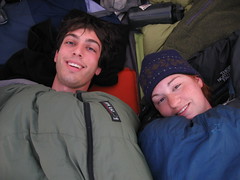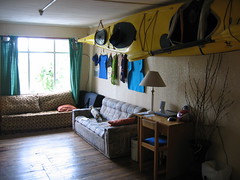Day 6: My checklist
23 February 2007
12:00 AM
Torres del Paine — Day 6
February 5, 2007
Amanda and I slept at Campamento Grey, the end point of the W trail. The edge of Grey Glacier was a short distance from our tent. The view was impressive, but a couple hikers told us that the view of the glacier from the next campsite, another hour along the trail, was spectacular. Our boat was leaving at 9:30am, so this was our plan: get up at 6:00, pack up camp, leave for the next site at 6:30, arrive at 7:30, return at 8:00, and be back at camp by 9:00 to catch the boat. I know, it was a crazy idea.
When my alarm went off, I heard the heavy rain, I saw Amanda fast asleep, and I realized that I was tired. I blamed it on the 44 miles we had covered in the last five days. We weren’t the young kids we had been earlier in the week. It didn’t take long to decide that one early-morning, rain-infused wakeup was enough for me. I reset my watch and went back to sleep. Later, at a more civilized hour, we woke up, ate breakfast, and packed up camp for the last time.
We wouldn’t be making the hike to the next camp, but there was another option. Visiting the look-out point the night before had been such a unique experience. The convergence of the scenery, the chill, and the wind made it a perfect place to end the trip. I had gone alone while Amanda slept, but the best things in life are meant to be shared. I wanted her to see the look-out point too. We stowed our packed bags under a tarp and took off jogging towards the look-out.
Grey Glacier was still there, staring us in the face when we arrived. The night’s precipitation had dusted the nearby peaks with snow. We took snapshots of each other, took in the view, and made our way back to camp, satisfied with the morning. Over the ridge I spotted the Grey II, the ship that would take us home, moving across the lake. I lagged behind on the trail, taking pictures of berries. We ran back to camp where I, not thinking we were pressed for time, used the bathroom. Suddenly I heard Amanda yell, “Hurry up—get your pack, I’ve got your shoes!” My watch read 9:25, but apparently the boat didn’t run on my time. A few days on the trail had made me lax with my timetables. The raft to take us to the boat was on its way out. I grabbed my pack and sprinted towards the shore. Amanda had to make them hold the raft until I got there while the Grey II waited farther off-shore with the rest of the passengers. My bathroom trip almost cost us our boat, but we made it and the raft ferried us out to the Grey II.
Of the thirty people on-board, we owned two of the four backpacks. Most were guests at park hotels, which made sense given the price of the ride. We dropped off our bags and went to the upper-deck. The cold wind whipped across our faces. A crew member served us pisco sours, the Chilean national cocktail, complete with ice chunks from the glacier. Drinking glacier ice felt a little like hunting an endangered animal, but I enjoyed the luxury. Our ship pushed through chunks of ice as we made a full pass along the edge of the glacier. According our guide, Grey Glacier is currently in a state of recession. During the twentieth century it lost thirteen feet a year. From 1994 to 2005, however, it lost over a mile of ice.
The ice that calved from the glacier was an unearthly blue. I had seen these frozen blue flames from afar the day before, but it was something else altogether to be floating among them. Just when I thought I had seen it all, we pulled alongside a small iceberg: it was the bluest ice in the world. I haven’t traveled everywhere, but I can’t imagine anything bluer—it would burn your eyes. The ice looked like a half-dozen things—a frozen piece of sky, water behind aquarium glass, crystal—but not like ice. Apparently ice’s blueness is related to the amount of bubbles in it; fewer bubbles equals more blue. The captain steered our boat into the iceberg and an aspiring comic crew member shouted, “Look, it’s Titanic!” I thought her timing was off. With the iceberg floating at our stern, we could reach out and touch it. People lined up along the prow of the boat to admire the ice. Once we had seen it, Amanda and I ducked into the cabin to avoid the latest Patagonian rainstorm.
A couple hours later we landed at the south end of Grey Lake. From there we rode in a pickup truck to the park administration building. Through the window we said our goodbye to the Cuernos and the Torres in the distance. At the admin building the bus picked us up for the trip back to Puerto Natales. We loaded our backpacks into the bus’s gut. I made a point of taking out my book so I could read during the trip. A few minutes later, I fell asleep, dutifully holding Isabel Allende’s Mi Pais Inventado on my lap. It stayed there, unopened for the next three hours.
In Puerto Natales we returned our rental stove and trusty pot. Then we checked into Erratic Rock, a hostel that Amanda picked out. The place fit my romanticized vision of a hostel perfectly. It was a cozy place run by people with ties to Patagonia, mostly trekkers who came to visit and never left. There were large, open common rooms with soft couches and stoves. Several hundred VHS tapes—every movie imaginable—lined the downstairs shelves. The shared rooms had hardwood floors. Snowboards and kayaks were mounted on the walls. In the morning, Bill cooked us a “trekker’s breakfast.” The night cost $12.
We shared a room with a woman from Northern Ireland who was on her way into Torres del Paine the next day. We started telling her stories from our short stay in the park, interspersed with advice on what to see and how to do it. Maybe we overwhelmed her. She listened excitedly, but then added, “Well, I’m not an expert like you guys. I’m just going into the park and I’ll see what I can do.” An expert? Two weeks ago I knew next to nothing about backpacking. I’m not an expert, and I told her as much.
But our Irish roommate’s comment got me thinking about what I had learned in the last week. Amanda had taken a few courses when she was at college in Utah, a perfect place for outdoor learning, so she had a legitimate understanding of what to do in the wilderness. Along the trail, she passed much of it along to me. Now I could select a good location for our tent and pitch it in five minutes. I learned what gray water is and how to dispose of it. I could read the contour lines on a map to see how difficult a day’s hike would be. I mastered lighting our gas stove (admittedly not that difficult, but it’s something). I felt confident that I could plan the meals for a trip myself now. I carried my 45 pound pack without a complaint. I thought I could go one-on-one with a puma and come out the winner. That’s wrong, of course, but it shows you what a week on the trail had done to my ego. Expert, no. But I wasn’t a clueless amateur anymore, either.
The next day we returned to Punta Arenas and caught our plane back to Santiago, leaving the ruggedness of Patagonia behind us. On the flight I started thinking about checklists, of all things. Many people keep checklists of things to do before they die. Going to Torres del Paine had not been on my list, even though it seems just like the kind of thing that should be. Would it be cheating, I wondered, if I put it on the list just to cross it out?. The problem with life checklists, though, is that they are prone to rapid growth. Cross off one box and four more appear to take its place. Already I caught myself wondering where I could go backpacking in the U.S. Or what about the rest of South America? I was in trouble.
A few days later I was reviewing my journal when I got to the last line from one night on the trail: “I want to come back some day to do the complete circuit.” A couple months ago the idea of backpacking sent me reeling with worries, and here I was ready to return. My list was growing.
When asked why he climbed Mt. Everest, George Mallory replied, “Because it is there.” Now that was how I felt about Torres del Paine National Park. Why would I go back? Why not? I had been there once. I had lived to tell the story. The end of the world is spectacular, and it turns out that it’s not that far away.






Comments